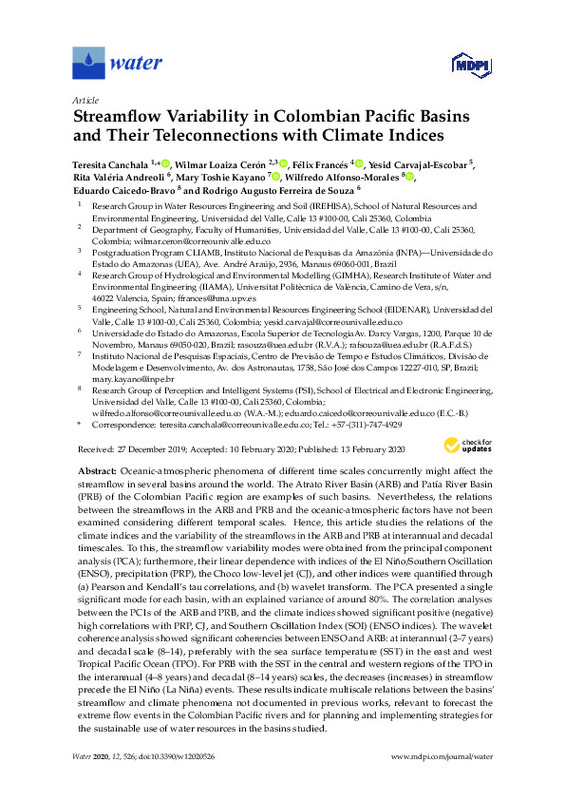|
Resumen:
|
[EN] Oceanic-atmospheric phenomena of different time scales concurrently might affect the streamflow in several basins around the world. The Atrato River Basin (ARB) and Pa-Ha River Basin (PRB) of the Colombian Pacific ...[+]
[EN] Oceanic-atmospheric phenomena of different time scales concurrently might affect the streamflow in several basins around the world. The Atrato River Basin (ARB) and Pa-Ha River Basin (PRB) of the Colombian Pacific region are examples of such basins. Nevertheless, the relations between the streamflows in the ARB and PRB and the oceanic-atmospheric factors have not been examined considering different temporal scales. Hence, this article studies the relations of the climate indices and the variability of the streamflows in the ARB and PRB at interannual and decadal timescales. To this, the streamflow variability modes were obtained from the principal component analysis (PCA); furthermore, their linear dependence with indices of the El Nino/Southern Oscillation (ENSO), precipitation (PRP), the Choco low-level jet (CJ), and other indices were quantified through (a) Pearson and Kendall's tau correlations, and (b) wavelet transform. The PCA presented a single significant mode for each basin, with an explained variance of around 80%. The correlation analyses between the PC1s of the ARB and PRB, and the climate indices showed significant positive (negative) high correlations with PRP, CJ, and Southern Oscillation Index (SOI) (ENSO indices). The wavelet coherence analysis showed significant coherencies between ENSO and ARB: at interannual (2-7 years) and decadal scale (8-14), preferably with the sea surface temperature (SST) in the east and west Tropical Pacific Ocean (TPO). For PRB with the SST in the central and western regions of the TPO in the interannual (4-8 years) and decadal (8-14 years) scales, the decreases (increases) in streamflow precede the El Nino (La Nina) events. These results indicate multiscale relations between the basins' streamflow and climate phenomena not documented in previous works, relevant to forecast the extreme flow events in the Colombian Pacific rivers and for planning and implementing strategies for the sustainable use of water resources in the basins studied.
[-]
|
|
Agradecimientos:
|
The first author was supported by the Program for Strengthening Regional Capacities in Research, Technological Development and Innovation in the department of Naritio and the CEIBA foundation for doctoral studies. The ...[+]
The first author was supported by the Program for Strengthening Regional Capacities in Research, Technological Development and Innovation in the department of Naritio and the CEIBA foundation for doctoral studies. The second author was supported by the Doctoral Scholarship of the Coordenacao de Aperfeicoamento de Pessoal de Nivel Superior Brazil (CAPES) Finance Code 001 and Universidad del Valle (Cali-Colombia). The Conselho Nacional de Desenvolvimento Cientifico e TecnolOgico (CNPq) of Brazil partially supported the fifth and sixth authors under grants 305942/2015-8 and 302322/2017-5, respectively. This research was done partially during an internship of the first two authors at the Research Institute of Water and Environmental Engineering of the Universitat Politecnica de Valencia. This work was also supported by the Spanish Ministry of Science and Innovation through Project TETISCHANGE (RTI2018-093717-B-I00). We are thankful to the research groups IREHISA and PSI of the Universidad del Valle. The authors thank the anonymous reviewers for their useful suggestions.
[-]
|









